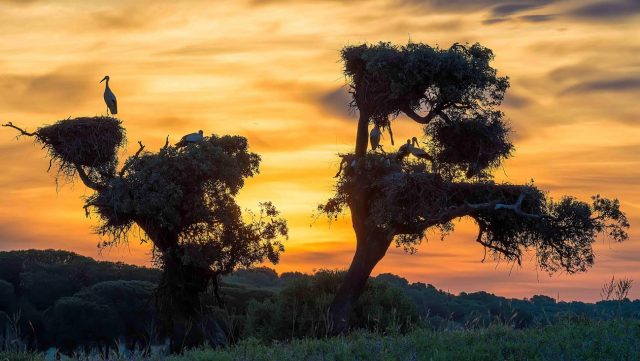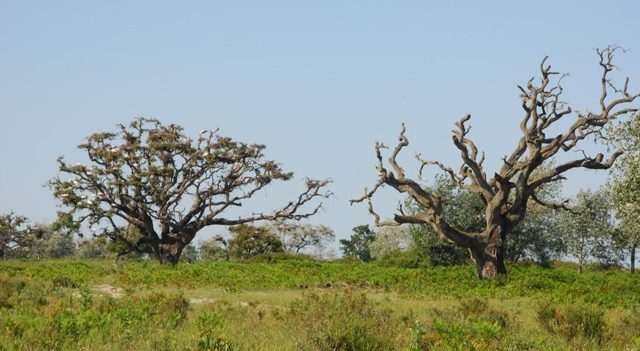When protection leads to degradation

Doñana National Park, at the South-western coast of Spain, is known to host several species of wading birds. These piscivorous birds nest in colonies in the neighboring woodlands, formed by cork oaks, close to the marshals where they feed. Ever since the park was opened, the population and nesting of birds, most of them endangered species, it has been increasing every year as a result of the waterbird protection initiatives. Therefore, their impact on this habitat has also increased over the years.
Researchers from CSIC and the University of Zurich have found 1 that the overpopulation of nesting birds in Doñana is leading to a degradation of the habitat caused by the excess of guano, among other reasons. Accumulation of excrement results in several chemical changes in the soil, which the authors call the “bird chemical footprint”.
The research has focused on the nesting areas of seven wading birds species. Thus, the study area has been bound between the marshland and the woodland, which is known as “La Vera de Doñana”, where several thousand pairs of birds establish themselves for the wintering and nesting.
Salinization, an increase of pH and the input of nutrients would be the main characters of this chemical footprint, from which the detrimental effects would affect the microbial communities to a greater extent. However, these changes don’t appear in the same fashion during the wet and the dry season as there is more accumulation of guano during the dry season.
Naturally, cork oak forests are characterized by nutrient-poor soils limited in phosphorus. On the other hand, forests nearby Doñana accumulate vast amounts of guano, which is very rich in biological available forms of this element and others, such as nitrogen, representing a huge difference in the chemical composition of the soil.
It seems obvious that the chemical footprint will affect the microbial compositions that live in the soil. The authors explain in this research how diversity and activity changes in most of the microbiological groups: Bacteria, Archaea and Fungi.
First of all, the excess of chemical elements introduced in the soil lead to eutrophication: This is a consequence of the alteration of the microbial communities by overgrowth of microorganisms and a number of physiological changes such as respiration, enzymatic activities and increase in microbial biomass whereas many other processes are inhibited, like the ones responsible of bacterial nitrification due to the high salinization. This last effect together with the uric acid decomposition products are the reason for the ammonium-N (N-NH4) accumulation in the soil.
Also, high salinity in soils happens to be toxic, but the availability of organic carbon seems to minimize this effect. Despite this, the increase of salinity still generates a selective pressure among the soil living organisms. However, the major effects on the microbial communities appear to be caused by alkalinization (increase of pH) of these soils and accumulation of organic nitrogen and phosphorous. Alkalization severely affects microbial populations, which influence tree growth and health. Because these natural areas are typically acidic (low pH around 5.5), their communities are used to these conditions. Those changes in nutrients and pH affects soil microbial communities generating drastic changes in their composition, abundance and metabolic activities.
Although a big difference in fungi biodiversity was expected, the results didn’t show that much difference in the quantity of taxa. Still, there is probably a deviation in the bulk population, dominated by coprophilous (excrement eaters), where mycorrhizal and ligninolytic should be the main populations in this type of soil.
Unlike the results from Fungi, bacterial diversity decreases as the nesting activity intensifies in the area. This is because the original bacterial communities are sensitive to changes in the pH, the availability of organic matter, the type of carbon source and the excess of elements such as nitrogen and phosphorous. These nutrients – which lack usually limit bacterial growth- come from the avian detritus and due to the increase of litterfall accumulation caused by the avian activity.
Regarding to Archaea, these populations were the ones that held the biggest changes in their diversity: The populations from the phylum Crenarchaeota were the most spread, since they have shown to metabolize ammonia. Fertilization with guano-belonging uric acid seems to be an important selective pressure that benefits microbes with this physiology, not only with other archaea but also with bacteria, since the last ones are less fit to salty environments than archaeal ones. These populations have shown to be highly sensible to conditions where soils get rich in nitrogen.
All these factors drastically alter the composition of the microbial communities and their physiology. These alterations have direct influence on the growth and well-being of the trees used for nesting.

Much research, this one included, has noted, for the reasons previously explained and many others – like the intrinsic defoliation and physical damage of the trees by avian activity – that the oaks in the nesting area double their mortality rate compared to the ones that live out of this area.
Due to these results the authors urge: “The occurrence of detrimental effects of the oversized bird colony on soil chemical conditions, which alter the activity and composition of the native soil microbial communities and threaten the survival of the cork oak population in the area of the colony, obligates to a re-evaluation of the management strategies in the area, towards a greater consideration of soil processes in conservation priorities.”
To summarize, in the long term, overpopulation might be followed by cork oak forests’ decrease, turning into a habitat less likely to host nesting. Therefore, protection should stand to maintain ecosystems, and not only species, which will have a better future in healthy habitats.
References
- Dominguez, M. T., Gutiérrez, E., González-Domínguez, B., Román, M., Ávila J. M., Ramo, C., González, J. M., García J. V. (2017). Impacts of protected colonial birds on soil microbial communities: When protection leads to degradation. Soil Biology and Biochemistry, 105, 59-70. ↩
2 comments
[…] Zelan liteke zonalde natural bat babesteak berau andeatzea ekartzea? Manuel San Martínen When protection leads to degradation […]
[…] ¿Cómo es posible que proteger una zona natural lleve a que se degrade a ojos vista? Manuel San Martín en When protection leads to degradation […]